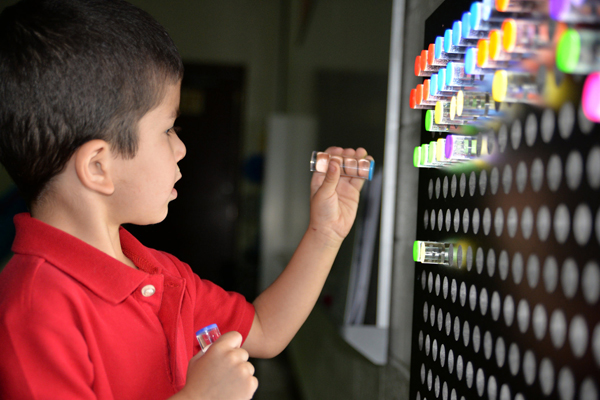- South Texas Students Meet Accordion Music Icons Los Tigres Del Norte In Edinburg Thanks To Khs America/Hohner Alianza Académica Initiative
- Fragile Planet Offers a Nighttime Wildlife Experience
- Falcons Soccer Off & Running
- Cameron County Receives Funds to Improve Two Parks
- Falcons Complete First Half of 32-6A
- School District to Help out Victims of California Wildfires
- Sand Castle Days Continued Despite Unexpected Weather
- Ready for District
- Discussion of Garbage Dumpster Rates, Agreements Between State & City on Highway Regulations, and More
- 31st Annual Shrimp Cook-Off is Right Around the Corner
Sensory Labs Bring Smiles to Special Needs Students
- Updated: September 14, 2018

by Ronnie Zamora/LFCISD
It’s no secret that most students with special needs learn best with hands-on activities.
Students are smiling with the introduction of sensory rooms that have been implemented at select schools – six elementary and all five secondary campuses.
“We are the first school district in the area to implement district-wide sensory rooms at all campuses that serve students with autism, developmental delays, and behavioral disorders in specialized classrooms,” said Griselda Wells, Los Fresnos CISD Director of Special Services. “Special education teachers are very excited to start using the sensory rooms to help their students learn self-regulation skills that will help them in the school, home and community settings.”
The updated sensory curriculum provides a means of understanding, developing awareness and making sense of their surroundings. It seems to help children improve, use and integrate their visual, auditory, tactile, gustatory, olfactory and kinesthetic awareness and skills.
Classrooms have been modified to accommodate the new activities that are intended to enhance academic, behavioral, and motor skills.
Many special-needs children see the world with the fingertips. They enjoy doing and feeling activities. Judging by the smiles on their faces, they are enjoying the new sensory rooms.
Their behavior in the classroom will be tracked by teachers to provide a baseline of data regarding the impact of the Sensory Room.
Los Fresnos CISD teachers and diagnosticians worked during the summer months to write a curriculum for the sensory rooms that will help guide other teachers through sensory activities, how to rotate students through the different sensory centers and the specific purpose of each activity.
Sensory room activities address the following areas of sensory processing: vestibular, visual input/lighting, olfactory, proprioception, tactile and auditory.
- Vestibular activities include hammock chairs, swings, exercise balls, waterbeds, and tactile walkway set.
- Visual input/lighting activities include interactive bubble tubes, acrylic mirrors, interactive hurricane tubes, fiber optic slide glows with light sources, rod walls, and glitter tubes.
- Olfactory activities include sniffy fruity scented balls
- Proprioception activities include therapy chairs, weighted items, baby rockers, vibrating floor pads and drums
- Tactile activities include tactile walkways, gel pads, fights and tactile disc sets.
- Auditory activities include interactive bubble tubes, music and drums.
Special education teachers and staff will supervise all sensory rooms. Depending on the needs of the campus and size of the room, 1 to 10 students will access the sensory room per scheduled block of time. Teachers and staff will take proper safety precautions for all students.
Sensory rooms will also be utilized by Related Service personnel such as Physical and Occupational Therapists to provide specialized services to students.
“Campuses will be organizing Parent Sensory Nights in order to familiarize parents with the new sensory rooms, how they will be used, and how they will help their children,” Wells said.
